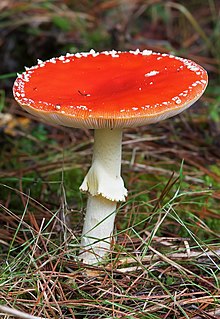Ethnomycology

Ethnomycology is the study of the historical uses and sociological impact of
psilocybin mushrooms, the Amanita muscaria mushroom, and the ergot
fungus.
American banker
John Marco Allegro, Clark Heinrich, John W. Allen, Jonathan Ott, Paul Stamets,Casey Brown and Juan Camilo Rodríguez Martínez
.
Besides mycological determination in the field, ethnomycology depends to a large extent on
While Wasson views historical mushroom use primarily as a facilitator for the
shamanic or spiritual experiences core to these rites and traditions, McKenna takes this further, positing that the ingestion of psilocybin was perhaps primary in the formation of language and culture and identifying psychedelic mushrooms as the original "Tree of Knowledge".[6] There is indeed some research supporting the theory that psilocybin ingestion temporarily increases neurochemical activity in the language centers of the brain, indicating a need for more research into the uses of psychoactive plants and fungi in human history.[7][8]
The 1990s saw a surge in the recreational use of
psilocybin mushrooms due to a combination of a psychedelic revival in the rave culture, improved and simplified cultivation techniques, and the distribution of both the mushrooms themselves and information about them via the Internet. This "mushrooming of mushroom use" has also caused an increased popularization of ethnomycology itself as there are websites and Internet forums where mushroom references in Christmas and fairy tale
symbolism are discussed. It remains open to interpretation what effect this popularization has on ethnomycology in the academic world, where the lack of verifiable evidence has kept its theories with their often far-reaching implications shrouded in controversy.
References
- ISBN 978-0-15-683800-9.
- ^ Feeney, Kevin (2020). "Fly Agaric: A Compendium of History, Pharmacology, Mythology, & Exploration". ResearchGate. Retrieved 2020-12-27.
- ISBN 978-0-915148-20-2.
- ISBN 978-0-340-12875-6.
- ISBN 978-0-89281-997-3.
- ISBN 978-0-553-37130-7.
- ^ "Neurometabolic Effects of Psilocybin, 3,4-Methylenedioxyethylamphetamine (MDE) and d-Methamphetamine in Healthy Volunteers A Double-Blind, Placebo-Controlled PET Study with FDG". Neuropsychopharmacology. 1999.
- ^ "Neural Correlates of Hallucinogen-induced Altered States of Consciousness". Archived from the original on 2005-09-08.
Sources
- Oswaldo Fidalgo, The ethnomycology of the Sanama Indians, Mycological Society of America (1976), ASIN B00072T1TC
- E. Barrie Kavasch, Alberto C. Meloni, American Indian EarthSense: Herbaria of Ethnobotany and Ethnomycology, Birdstone Press, the Institute for American Indian Studies (1996). ISBN 978-0-936322-05-6.
- Aaron Michael Lampman, Tzeltal ethnomycology: Naming, classification and use of mushrooms in the highlands of Chiapas, Mexico, Dissertation, ProQuest Information and Learning (2004)
- Jagjit Singh (ed.), From Ethnomycology to Fungal Biotechnology: Exploiting Fungi from Natural Resources for Novel Products, Springer (1999), ISBN 978-0-306-46059-3.
- Keewaydinoquay Peschel. Puhpohwee for the people: A narrative account of some use of fungi among the Ahnishinaubeg (Ethnomycological studies) Botanical Museum of Harvard University (1978),ASIN: B0006E6KTU
External links
- "Aboriginal use of fungi", Australian National Botanic Gardens Fungi Web Site.
- https://web.archive.org/web/20070206142346/http://www.huh.harvard.edu/libraries/wasson.html R.G. Wasson] - Harvard University Herbaria
- https://web.archive.org/web/20070320151934/http://www.bu.edu/classics/faculty/profiles/ruck.html Carl A.P. Ruck] - Boston University Department of Classical Studies
- Albert Hofmann Foundation
- Terence McKenna - Official site
- John W. Allen - Official site
- John M. Allegro - Official site
- https://web.archive.org/web/20070127105105/http://www.gnosticmedia.com/main/ Jan Irvin and Andrew Rutajit] - Official site
- Dan Merkur - Official site
- Michael Hoffman
- Visionary Mushrooms Studies in Ethnomycology with Contributions by Gaston Guzman and Albert Hofmann
